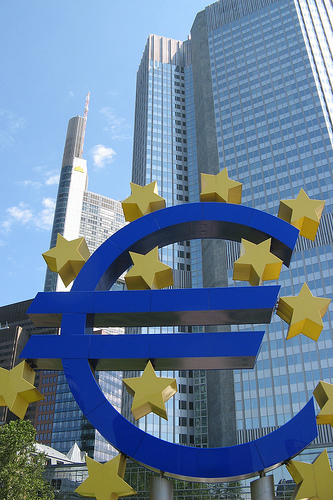The Euro

The euro is used used daily by about 327 million Europeans. After the American dollar, the euro is the second largest reserve currency and second most traded currency. There were over €751 billion in circulation in November 2008, making it the highest value of cash in circulation in the world.
Countries in the European Union that use the euro are called the Eurzone. They are: Austria, Belgium, Cyprus, Finland, France, Germany, Greece, Ireland, Italy, Luxembourg, Malta, the Netherlands, Portugal, Slovakia, Slovenia and Spain. In the EU, the United Kingdom, Sweden and Denmark all refuse to go under the euro. The Czech Republic, Hungary, Poland, Romania and Bulgaria still use their own currencies.
The Eurozone is set to enlarge within the next few years. In addition, outside of the European Union, Montenegro and Kosovo use the euro as the sole currency. There are a few European microstates outside the EU also use the euro: Andorra, Monaco, San Marino and Vatican City. The euro also is used overseas, in places like Mayotte, Saint Pierre and Miquelon, Akrotiri and Dhekelia, Saint Barthelemy, Guadalupe and Saint Martin. Cuba, North Korea and Syria often use the euro for trading. When you are in Europe and want to go to a hotel, such as in Turkey or the Czech Republic, they will often accept euros. The same goes for many restaurants in tourist-frequented areas in capital and famous cities.
The euro is handled by the European Central Bank in Frankfurt, Germany, and by the Eurosystem, which is a collection of the central banks in the Eurozone countries. The Eurosystem banks print, mint and distribute the money throughout their respective countries.
The euro is divided into 100 cents, which are sometimes called euro-cents. Coins are issued in €2, €1, 50-cent, 20-cent, 5-cent, 2-cent and 1-set denominations. The 2-cent and 1-cent are very rarely used, and the Netherlands and Finland round everything up to the nearest 5-cents to avoid them. The paper money comes in values of €5, €10, €20, €50, €100, €200 and €500, but the last two are rarely used.
The concept of the euro was introduced in December 1995. It was started as an accounting currency in 1999, in the sphere of world financial markets, which replaced the former European Currency Unit. It came to a material currency in 2002.
